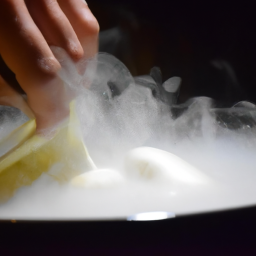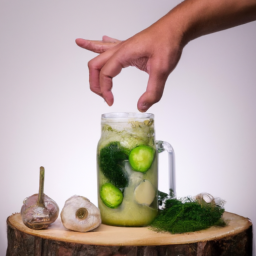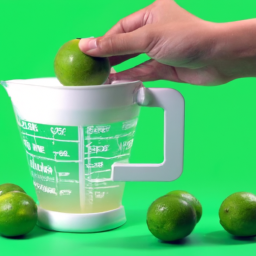Ever felt the urge to craft your own mozzarella cheese but felt daunted by the procedure? Worry not, dear cheese aficionados, as I have unearthed an easy and tasty method to produce mozzarella cheese with the help of lemon juice.
It may seem like an unlikely pairing, but the acidity of the lemon juice helps to curdle the milk and create the perfect texture for this classic Italian cheese.
Picture yourself in a quaint Italian village, surrounded by rolling hills and fields of grazing cows. The sun is shining and the air is filled with the sweet aroma of freshly made cheese.
Now, bring that image back to reality and let me show you how to recreate that experience in your own kitchen with just a few ingredients and some simple steps. With this recipe, you’ll be able to impress your friends and family with your homemade mozzarella cheese, and they’ll never believe how easy it was to make.
So, let’s get started on this cheesy adventure!
Key Takeaways
- Gradually adding lemon juice is important for even curdling
- Straining the curds using cheesecloth is common
- Kneading the cheese creates a smooth, elastic texture
- Cheese should be chilled in the fridge to firm up and enhance flavor
Gather Your Ingredients
You’ll need to gather all the ingredients for making mozzarella cheese with lemon juice before you can start creating the perfect cheese.
Firstly, you need to choose the right type of milk for your cheese. The best milk to use is fresh, whole milk, as it contains the necessary proteins and fats needed for the cheese to form properly. However, you can also use lower-fat milk options like 2%, or even non-dairy milk alternatives like soy or almond milk for a vegan option.
Next, you’ll need to select the right type of acid for the cheese-making process. While lemon juice is the most popular option, you can also use other acids like vinegar or citric acid. It’s important to note that using different acids can affect the final taste and texture of the cheese. For example, lemon juice can give your cheese a slightly tangy flavor, while vinegar can make it more tart.
With your milk and acid selected, you’re ready to move on to the next step: heating the milk.
Heat the Milk
Once the milk is on the stove, crank up the heat and wait for it to start bubbling. It’s important to choose the right type of milk for cheese making. Whole milk is the best option as it contains the right amount of fat and protein needed for mozzarella cheese. However, you can also use low-fat or skimmed milk if that’s all you have.
When heating the milk, you should use specific heating techniques to ensure that the milk doesn’t burn or scorch. The best way to do this is to use a double boiler or a heavy-bottomed pot. This will distribute the heat evenly and prevent the milk from sticking to the bottom of the pot. Keep stirring the milk occasionally to avoid burning.
Once the milk reaches a temperature of around 85-90 degrees Celsius, it’s ready for the next step of adding the lemon juice.
Now that the milk has reached the desired temperature, it’s time to add the lemon juice.
Add the Lemon Juice
Now it’s time to add the lemon juice to the heated milk. I’ll gradually pour in the lemon juice while stirring the mixture continuously. It’s important to stir the mixture thoroughly to ensure that the lemon juice is evenly distributed throughout the milk.
Adjust the paragraph structure in the Input to logically group complete sentences on their own lines, with a double new line after. Use contractions.
Gradually Add the Lemon Juice
As you add the lemon juice, the milk will begin to curdle, transforming into the delicious mozzarella cheese you crave. It’s important to add the lemon juice gradually, as adding too much at once can cause the curdling process to happen too quickly and result in a less-than-ideal texture. Using lemon juice as the acid for cheese making is just one option, as other acids like vinegar or citric acid can also be used. Additionally, there are various techniques for shaping the cheese into different forms, such as stretching and molding into balls or braids.
To ensure that the curdling process happens evenly and smoothly, I like to use a table to measure out the lemon juice and slowly pour it into the milk. In a 2 column and 3 row table, I measure out the lemon juice in one column and the corresponding amount of milk in the other column. Then, I pour in a small amount of lemon juice at a time, stirring gently between each addition until the milk has fully curdled. This technique helps me achieve the perfect texture for my mozzarella cheese every time.
With the lemon juice added, the next step is to stir the mixture to distribute the acid evenly.
Stir the Mixture
To evenly distribute the acid throughout the mixture, I’ll want to give it a good stir. Think of it like mixing up a salad dressing – just like I want all the ingredients to blend together smoothly, I’ll want to make sure the acid is evenly distributed throughout the curds.
There are different ways to stir the mixture, and each method will produce different results. Here are some alternative stirring methods that I’ve found to be effective:
-
Use a whisk: This is a great option if you want to break up the curds and incorporate the acid quickly. Whisking will create small curds and a firmer cheese.
-
Use a spoon: This method is slower, but it will produce larger curds and a softer cheese. Use a large spoon to gently stir the mixture, making sure not to break the curds too much.
-
Use your hands: If you’re feeling adventurous, you can use your hands to knead the curds and distribute the acid. This method requires a bit more effort, but it can produce a very smooth and creamy cheese.
It’s important to stir the mixture for a longer period of time if you want a firmer cheese. The longer you stir, the more the curds will come together and the more whey will be expelled. This will result in a cheese that is less moist and more compact. However, if you prefer a softer cheese, a shorter stirring time is recommended.
Once the curds have been stirred to your desired consistency, it’s time to move on to the next step: straining the curds.
Strain the Curds
To strain the curds, I use a cheesecloth that I’ve soaked in hot water to make it sterile.
I lay the cheesecloth over a colander set over a large bowl, and pour the curds and whey into the cheesecloth.
Then, using my hands, I gently squeeze out the excess liquid from the curds.
Use a Cheesecloth
Don’t forget to grab a cheesecloth to help strain the curds from the whey! Using cheesecloth is a common way to strain the curds from the whey. The cheesecloth allows the liquid to pass through while retaining the solid curds.
However, it’s important to note that using cheesecloth has its pros and cons. One advantage of using cheesecloth is that it’s widely available and affordable. Additionally, there are different types of cheesecloth that can be used for making cheese, such as cotton or muslin.
However, a potential downside is that the cheesecloth can sometimes tear or break during the straining process, which can result in a mess and loss of curds. To prevent this, make sure to use a high-quality cheesecloth and handle it with care.
Now that the curds have been strained using the cheesecloth, it’s time to squeeze out the excess liquid.
Squeeze Out the Excess Liquid
Once the curds have been strained and separated from the whey, it’s time to gently squeeze out any excess liquid using a clean cloth or paper towel. This step is crucial to removing moisture from the cheese and achieving the desired texture.
To do this, I take a cheesecloth and wrap the curds tightly, squeezing out any remaining liquid. I use a technique where I twist the cheesecloth at the top of the curd and gently apply pressure to release the liquid. I continue to do this until the cheese has reached the desired moisture level.
It’s important not to over-squeeze the cheese, as this can result in a dry and crumbly texture. Once the excess liquid has been removed, I move on to shaping the cheese into a ball using the cheesecloth.
Shape the Cheese
Now that I’ve strained the curds, it’s time to shape the cheese.
The first step is to add salt to taste, which’ll enhance the flavor and also help preserve the cheese.
Then, I need to knead the cheese to create a smooth, elastic texture that’ll hold its shape.
Add Salt to Taste
Sprinkle a pinch of salt onto the creamy curds, allowing the flavor to meld perfectly with the tangy lemon juice. The amount of salt to add depends on personal preference, but about a teaspoon per pound of cheese is a good starting point. You can experiment with different types of salt to see what works best for your taste. Some popular options include sea salt, kosher salt, and Himalayan pink salt.
If you want to add some extra flavor to your mozzarella cheese, you can also mix in some herbs such as basil or oregano. Simply chop up the herbs finely and sprinkle them over the cheese before shaping it. This will give the cheese a delicious and aromatic taste that pairs well with a variety of dishes.
Once the salt and any additional ingredients have been added, it’s time to move onto the next step: kneading the cheese.
Knead the Cheese
After adding the salt and herbs, it’s time to get your hands dirty and knead the curds until they become smooth and stretchy. Kneading is a crucial step in the process of making mozzarella cheese, as it helps to develop the cheese’s texture and flavor.
Here are some tips for kneading cheese:
- Use a gentle touch: While kneading, it’s important to be gentle with the cheese. Avoid squeezing or pressing too hard, as this can cause the curds to break apart and result in a grainy texture.
- Stretch the cheese: To develop the cheese’s stretchiness, gently pull and stretch the cheese with your hands. This helps to align the proteins within the cheese and create a smooth, elastic texture.
- Work quickly: Kneading should be done quickly, as the cheese will become more difficult to shape and stretch as it cools. Keep this in mind and work efficiently to ensure that the cheese develops properly.
Variations of kneading techniques exist, so experiment with different methods to see which one works best for you.
Once the cheese has been kneaded to your satisfaction, it’s time to move on to the next step: heating the cheese.
Heat the Cheese
Alright, now that we’ve shaped the cheese, it’s time to heat it up.
First, I’ll grab a pot and fill it with water. Then, I’ll bring the water to a boil on the stove.
Once the water is boiling, I’ll gently submerge the cheese into the pot and allow it to heat up for a few minutes.
Boil Water in a Pot
First things first, let’s get the water boiling in a pot to start our mozzarella cheese-making journey. Boiling water is an essential step in making cheese as it helps to sterilize the water, making it safe for use and preventing the growth of harmful bacteria. Using boiled water also helps to maintain the pH level of the milk, which is crucial in cheese-making. Unlike other methods of heating milk, boiling water heats the milk evenly, ensuring that the cheese has a smooth texture and consistent taste.
To boil the water for cheese making, follow these simple steps:
- Fill a large pot with enough water to cover the cheese.
- Place the pot on a stove and set the heat to high.
- Wait for the water to come to a rolling boil, with large bubbles breaking the surface of the water.
- Turn off the heat and let the water cool down for a few minutes before submerging the cheese.
Use a thermometer to measure the temperature of the water, which should be around 80-85°C for best results.
With the water boiling and ready, let’s move on to the next step of submerging the cheese in the water to start the cheese-making process.
Submerge the Cheese in the Water
To submerge your cheese in the boiling water, carefully lower it into the pot using a slotted spoon or ladle while gently stirring the water to ensure even heating. You can also use other liquids like whey or vinegar to submerge the cheese, but water is the most common and easy to use. The texture of the cheese may vary depending on the liquid used.
If you use water, the cheese will have a slightly firmer texture, while using whey will result in a softer, creamier texture. On the other hand, using vinegar will make the cheese more tangy and acidic.
Once the cheese is submerged in the water, let it sit for a few minutes until it reaches a temperature of 170°F. You can use a thermometer to check the temperature. Once it reaches the desired temperature, use the slotted spoon or ladle to remove the cheese from the water and place it on a plate.
Now it’s time to stretch the cheese.
Stretch the Cheese
Now that the cheese is heated and ready, it’s time to stretch it. To handle the hot cheese, I always make sure to wear gloves for protection.
Then, I begin stretching the cheese, pulling it apart until it’s smooth and shiny. This process is crucial for achieving the desired texture and flavor of the mozzarella cheese.
Use Gloves to Handle the Hot Cheese
Before handling the hot cheese, make sure to put on some gloves to avoid burning your hands. Wearing gloves has several benefits when working with hot cheese.
First, it protects your hands from the high temperature of the cheese, which can cause serious burns. Second, it helps prevent the cheese from sticking to your hands, which can make it difficult to stretch and shape the cheese properly.
If you don’t have gloves available, there are a few alternatives to using gloves for handling hot cheese. One option is to use a damp cloth to protect your hands from the heat. Simply wet the cloth with cold water, wring it out, and then use it to handle the cheese. Another option is to use a pair of tongs or a spatula to move the cheese around. However, keep in mind that these tools may not provide as much control or precision as gloves.
Now that you have protected your hands with gloves or alternative methods, it’s time to stretch the cheese until it is smooth and shiny.
Stretch the Cheese Until It is Smooth and Shiny
As you stretch the warm, gooey cheese, it will gradually become smoother and shinier under your skilled hands. This step is crucial to achieving the perfect texture for your homemade mozzarella cheese. To stretch the cheese, you will need to use a combination of stretching techniques, including the fold and pull method and the spinning method. The goal is to create a smooth, elastic texture that will give your cheese the signature stretchy quality it’s known for.
To help you perfect your stretching technique, here is a handy table outlining the different methods you can use:
| Stretching Technique | Description |
|---|---|
| Fold and Pull | Fold the cheese over itself and pull the ends apart, then repeat. |
| Spinning | Hold the cheese in both hands and spin it like a wheel, stretching as you go. |
Remember to work quickly while the cheese is still warm and pliable. Once it cools down, it will become harder to stretch and shape. Once you’ve achieved the desired texture, move on to the next step of chilling the cheese.
Chill the Cheese
You’ll want to give your cheese some time to cool off in the fridge until it’s as cool as a cucumber. Cooling the cheese is an essential step in the cheese-making process. Not only does it help the cheese firm up, but it also enhances its flavor.
Here are some tips for chilling homemade cheese:
- Wrap it tightly – to prevent any air from getting in and drying out the cheese.
- Place it in a container – to protect it from any moisture or odors in the fridge.
- Let it cool off completely – this could take a few hours or overnight, depending on the size of your cheese.
- Store it in the fridge – this will help keep the cheese fresh for a longer period.
Different ways to use homemade mozzarella cheese in recipes include adding it to pizzas, sandwiches, pastas, salads, and more. Now that your cheese is chilled, it’s time to move on to the next step – storing the cheese.
Store the Cheese
To keep your homemade mozzarella fresh and delicious, it’s important to store it properly. There are a few storing methods that you can try, depending on how long you plan to keep the cheese.
If you’re planning to consume it within a few days, you can wrap it tightly in plastic wrap and store it in the refrigerator. Be sure to change the plastic wrap every day to prevent moisture from building up and turning your cheese into a soggy mess.
If you’re planning to keep your mozzarella cheese for longer than a few days, you can store it in a brine solution. To make the brine solution, dissolve 2 tablespoons of salt in 2 cups of water. Once the solution has cooled, place your cheese in a clean jar and pour the brine over it, making sure that the cheese is completely submerged. Your homemade mozzarella cheese stored in a brine solution can last up to 2 weeks in the refrigerator.
Now that you know how to store your homemade mozzarella cheese, it’s time to enjoy it! Whether you’re using it to make a delicious homemade pizza or adding it to your favorite pasta dish, your homemade mozzarella cheese will add a fresh and delicious flavor to any meal.
Enjoy Your Homemade Mozzarella Cheese!
Now it’s time to savor your fresh, homemade mozzarella and add a burst of flavor to any of your favorite dishes! Here are some ways to use your homemade mozzarella cheese:
- Top off your homemade pizza with freshly grated mozzarella cheese.
- Add some slices of mozzarella to your favorite sandwich or panini.
- Sprinkle some crumbled mozzarella on top of a garden-fresh salad.
- Melt some mozzarella on top of your favorite pasta dish for a creamy and delicious finish.
While making mozzarella cheese with lemon juice is a fun and rewarding process, it can sometimes result in a texture that is not as firm as store-bought cheese.
Here are some tips for improving the texture of your homemade mozzarella cheese:
- Make sure to use whole milk, as it contains more fat and will result in a firmer cheese.
- Be sure to heat the milk to the correct temperature and use a good quality rennet for optimal results.
- Stretch and knead the cheese for a longer period of time to encourage a firmer texture.
- Store your cheese in a brine solution to help maintain its shape and texture.
By following these tips and experimenting with different ways to use your homemade mozzarella cheese, you can enjoy a delicious and satisfying culinary experience!
Frequently Asked Questions
How long does homemade mozzarella cheese last?
On average, homemade mozzarella cheese lasts about a week when stored properly in the refrigerator. To extend shelf life, wrap in plastic wrap or store in an airtight container. Avoid freezing, as it can alter the texture.
Can I use other types of citrus juice instead of lemon juice?
Yes, other citrus juices can be used to make mozzarella cheese, but acidity levels must be considered. Lime juice has a higher acidity and can result in a tangier flavor, while orange juice has lower acidity and a sweeter taste.
Can I make mozzarella cheese with non-dairy milk?
Non dairy alternatives can be used to make mozzarella cheese. Health benefits include lower cholesterol and lactose intolerance. Technical precision is necessary to achieve the right texture and flavor. Allusion to the satisfaction of creating your own cheese.
What can I do with the leftover whey from making mozzarella cheese?
I often use the leftover whey from cheese-making in recipes such as smoothies, soups, and bread. It’s high in protein, vitamins, and minerals. Try searching for whey recipes online for more ideas on how to use it.
Do I need any special equipment to make mozzarella cheese at home?
To make mozzarella cheese at home, Cheese Cloth Alternatives like muslin cloth or a clean cotton shirt can be used. Rennet can be substituted with vinegar or lemon juice. Special equipment like a thermometer and a large pot is required.
Conclusion
So there you have it, my step-by-step guide on how to make delicious mozzarella cheese using lemon juice. It may seem daunting at first, but with practice, it becomes easier and more enjoyable each time.
Did you know that the average American consumes about 23 pounds of cheese each year? That’s a lot of cheese! But why settle for store-bought when you can make your own fresh mozzarella cheese right at home? Not only is it more cost-effective, but it also allows you to control the quality and flavor of your cheese.
Remember to always use high-quality ingredients and to follow the steps carefully for the best results. With a little patience and practice, you’ll be able to impress your friends and family with your homemade mozzarella cheese.
So go ahead, give it a try and enjoy the satisfaction of creating your own delicious cheese!
Ilana has been a vegan for over 10 years. She originally made the switch for health reasons, but soon found herself becoming more and more passionate about the ethical and environmental implications of a vegan lifestyle. Ilana is the author of The Graceful Kitchen, a blog all about veganism. She loves to cook up delicious and nutritious vegan meals, and share her recipes with others who are interested in leading a cruelty-free life. Ilana is also a strong advocate for using whole foods as the foundation of a healthy diet, and believes that going vegan is one of the best ways to achieve this.










